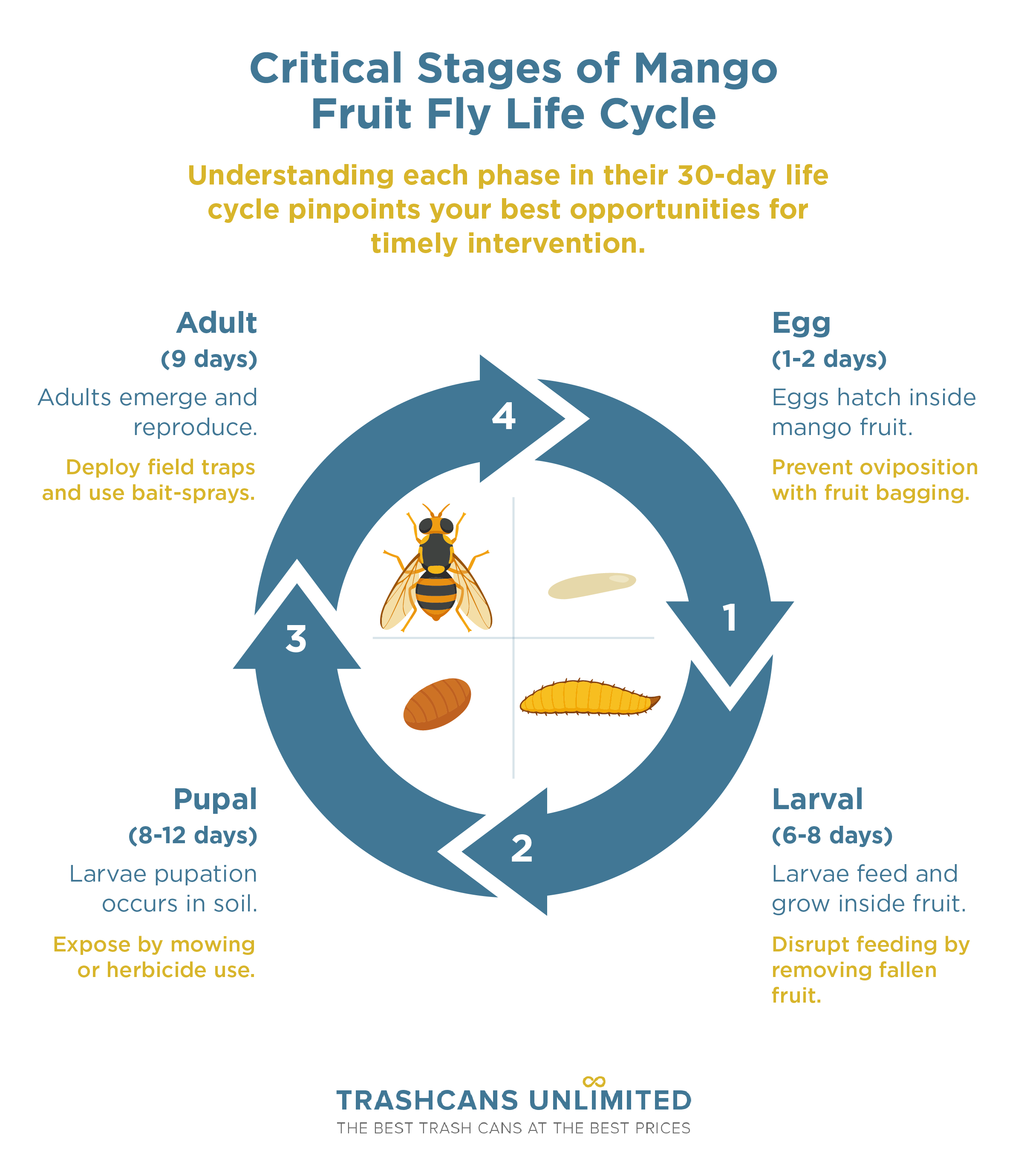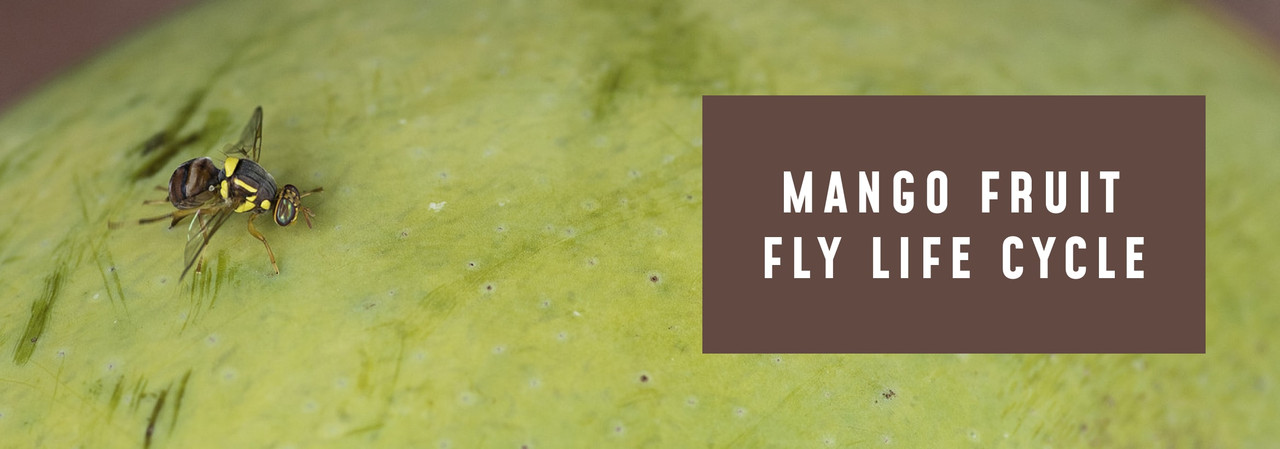Mango fruit flies are a persistent issue in tropical fruit farming, threatening the livelihoods of growers across the globe. The full mango fruit fly life cycle unfolds over 30 days in ideal conditions, progressing through egg, larval, pupal, and adult stages. The larval phase is especially destructive, directly damaging fruit quality. Warmer temperatures speed up this progression, while cooler conditions slow it down.
Key Takeaways
- Mango fruit flies complete their life cycle in about 30 days in warm climates.
- Larvae cause the most serious economic losses to mango crops.
- Monitoring and integrated pest control are essential to mitigate infestations.

Understanding the Threat
You face a formidable foe in the oriental fruit fly (Bactrocera dorsalis), which attacks over 400 hosts, including mangoes, and can devastate more than three-quarters of a crop if left unchecked. Female flies puncture fruit to lay eggs beneath the skin; larvae tunnel through the flesh, triggering early ripening and drop. You’ll notice soft indentations, tiny oviposition scars, and premature fruit drop. Secondary pests like mealybugs exacerbate damage by wounding fruit and inviting more flies.
Weekly monitoring with field traps reveals activity spikes, guiding timely interventions. In Florida, outbreaks peak with summer rainfall (June–August) when warm, humid conditions speed the mango fruit fly life cycle and reproduction. Recognizing these local patterns lets you anticipate and prevent fruit fly infestations more effectively.
Stages of the Mango Fruit Fly Life Cycle
Understanding each stage pinpoints your best intervention points. The complete life cycle from egg to adult emergence takes approximately 30 days under warmer conditions. However, the larval and pupal stages are highly temperature-dependent and can vary significantly.
Egg Stage
- Oviposition: Females insert batches of 3–30 eggs, 2–3 mm under the fruit skin.
- Hatch time: At 25–30 °C, eggs hatch in 1–2 days.
- Fecundity: Each female lays up to 1,500 eggs over her lifespan, clustering eggs in 10–15 per site.
Larval Stage
- Instars: Three larval instars feed on fruit pulp over 6–8 days in warm climates.
- Damage window: When you spot larvae, you’ve got roughly a week before larvae exit and irreversibly degrade fruit quality.
- Size: Mature larvae reach 8–10 mm and burrow into soil to pupate.
Pupal Stage
- Burial depth: Larvae pupate 2–5 cm deep in the soil.
- Duration: Pupation lasts 8–12 days under warm conditions; cool weather can extend this to over 30 days
- Survival factors: Soil organic matter boosts pupal survival and influences emergence timing.
Adult Stage
- Emergence: Adults emerge and require ~9 days to reach sexual maturity under summer conditions.
- Longevity: They live 1–3 months (up to 11 weeks in lab settings).
- Dispersal: Strong fliers, adults travel up to 30 miles seeking hosts.
- Feeding: Maturity depends on protein sources—decaying fruit, bird droppings, or bait stations.
Factors Influencing the Mango Fruit Fly Life Cycle
The length and success of each stage in the fruit fly’s development depend heavily on environmental and biological influences. These variables shape how quickly populations grow and how much damage they can cause.
Environmental Conditions
- Temperature: 25–30 °C accelerates development. Outside that range, each stage slows dramatically.
- Humidity & Rainfall: Moist, warm weather boosts egg and larval survival; extended rains can temporarily disrupt adult activity.
- Soil Quality: Rich organic soils enhance pupal survival, leading to quicker and more synchronized adult emergence.
Generational Overlap
Due to the long mango fruiting season and availability of alternate hosts, several generations of fruit flies can exist at once in the same orchard.
Female fecundity is another factor—each can lay hundreds of eggs, and if food and weather remain favorable, populations can balloon within weeks.
Nearby plants that also support fruit flies allow year-round reproduction, which compounds the pressure on mango orchards.
Population spikes often follow consecutive generations developing under consistently warm, humid conditions with ample food.
Integrated Pest Management Strategies
No single method is enough to manage mango fruit flies. Effective control involves layering different techniques that support one another. Integrated Pest Management (IPM) is a sustainable approach that helps growers reduce crop losses without over-relying on chemicals.
Biological Control
- Parasitic Wasps: Fopius arisanus (egg parasitoid) and Diachasmimorpha longicaudata (larval parasitoid) curb populations before peaks.
- Nematodes: Soil-applied entomopathogenic nematodes can lower adult emergence.
- Natural Predators: Encourage ants and ground beetles by reducing broad-spectrum insecticide use and maintaining ground cover.
Cultural Practices
- Trapping: Deploy 4–6 methyl eugenol traps per hectare and check weekly to guide interventions.
- Fruit Bagging: Cover fruit when small to physically prevent oviposition—ideal for high-value blocks.
- Sanitation: Collect and dispose of fallen fruit twice weekly. Bury infested fruit ≥50 cm deep or seal in compostable bags to interrupt the mango fruit fly life cycles.
Chemical Control
- Protein Bait-Sprays: Combine malathion or spinosad with protein bait to target adults selectively.
- Timing & Rotation: Apply only when trap data confirm activity; rotate modes of action to delay resistance.
General Cleanliness
- Ground Maintenance: Mow or apply targeted herbicide under trees to expose pupae to predators.
- Harvest Hygiene: Segregate damaged fruit at harvest and remove it from the orchard promptly.
Effective Control Measures: Target Every Stage of the Mango Fruit Fly Life Cycle
The most consistent results come from combining several techniques tailored to local conditions. Integrated Pest Management works best when prevention, monitoring, and treatment align.
Align prevention, monitoring, and treatment for best results:
- Frequent Trapping: Track real-time populations and trigger action thresholds.
- Rigorous Sanitation: Disrupt breeding by eliminating fallen fruit and debris.
- Judicious Insecticides: Use bait-spray programs tied to trap counts.
- Biological Augmentation: Release parasitoids early, focusing on hotspots.
- Protective Bagging: Shield premium fruit to guarantee market quality.
Clean orchards form the cornerstone of fruit fly prevention. Removing fallen fruits twice weekly cuts off access to developing larvae and prevents repeat mango fruit fly life cycles.
Protein baits paired with targeted insecticides can treat high-risk zones efficiently, especially when applied in alternating tree rows to minimize chemical exposure.
Encouraging natural enemies—by limiting broad-spectrum pesticide use and planting supportive habitat—adds another layer of control.
Protective fruit bagging, though labor-intensive, shields developing fruit and pays off when targeting premium markets.
Traps remain vital. Use them to determine when to act and evaluate the effectiveness of ongoing interventions. A density of 4 per hectare provides consistent data.
When executed well, IPM costs less than repeated pesticide applications and delivers stronger, more durable results. Trials consistently show up to 80% fewer damaged fruits when integrated techniques are used over conventional methods.
Seal the Deal on Fruit Fly Control: Elevate Your Orchard's Defense
You've mastered the art of Integrated Pest Management (IPM) to disrupt the mango fruit fly life cycle and get rid of fruit flies at every stage. Now, it's time to fortify your orchard's defenses with top-tier waste management solutions. Trashcans Unlimited offers an extensive range of commercial-grade trash cans designed to minimize pest attraction and enhance sanitation.
Explore our selection of durable, weather-resistant trash receptacles, including dome-top and sealed-lid models that effectively contain waste and odors, helping prevent fruit fly infestations and maintain a cleaner environment. By integrating these high-quality trash cans into your orchard management plan, you can significantly decrease the risk of infestations and maintain a cleaner, more productive environment.
Don't let inadequate waste management undermine your pest control efforts—get rid of fruit flies for good with proper sanitation solutions. Get a quote today and keep your orchard thriving.

